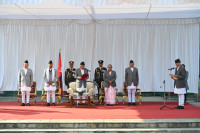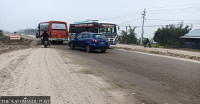National
Prolonged court cases delay transmission line projects
The 400kV Hetauda-Dhalkebar-Inaruwa Transmission Line Project is in limbo for over three years due to delays by the top court in deciding on a petition.
Prithvi Man Shrestha
It has been more than three years since the Supreme Court issued an interim order to prevent the construction of seven pylons at Padariya, in Lahan municipality of Siraha district under the 400 kV Hetauda-Dhalkebar-Inaruwa transmission line.
In January 2019, Sarita Giri, a politician and former minister, had filed a petition at the Supreme Court demanding a change in the route of the transmission line in the Padariya area and the court had issued an interim order accordingly.
“But after issuing the interim order, the Supreme Court has not conducted even a single hearing on whether to continue the order,” said Shyam Kumar Yadav, chief of the Nepal-India Electricity Transmission and Trade Project, under which the 400 kV Hetauda-Dhalkebar-Inaruwa and the 200 kV Bharatpur-Bardaghat transmission lines are being constructed.
According to him, the case was in the daily cause list of the Supreme Court on June 27. “The court on June 27 sought relevant documents from us and we submitted the documents on Wednesday,” Yadav said, adding that the court has scheduled a hearing for July 5.
With the court delaying hearing on the writ petition along with continued obstruction from locals in a few other locations, construction of one of the most important high capacity transmission lines has been affected, according to NEA officials.
Besides Padariya, locals have been obstructing the NEA’s effort to construct pylons in Hatiya of Makawanpur and Jiyajor of Lalbandi Municipality in Sarlahi.
“As a result, we have so far completed constructing 704 pylons out of the total 792 of the Hetauda-Dhalkebar-Inaruwa transmission line,” said Yadav. The total length of the transmission line is around 282km.
The importance of this project is that it is currently the only 400kV capacity line under construction for domestic power transmission through which 2,000MW power can be transported. The Dhalkebar-Muzaffarpur transmission line is the only completed project of 400kV capacity, but it is being used for export and import of electricity between Nepal and India.
The construction of the 400 kV Hetauda-Dhalkebar-Inaruwa and 220 kV Bharatpur-Bardaghat transmission lines had started in 2011 and both were supposed to be completed by 2016.
But a number of factors including local obstructions and disputes with the contractor delayed these projects, according to NEA officials.
As a result, the key financier of these two projects—the World Bank—discontinued its funding in November last year, according to the NEA.
Before withdrawing its funding, the World Bank had extended the project deadline several times. Obstructions from locals and legal cases against the projects, however, led to continued delays, said officials.
“If all the obstructions are removed immediately, we can complete the Hetauda-Dhalkebar-Inaruwa Transmission Line by 2023,” said Yadav.
Not only in the case of the Hetauda-Dhalkebar-Inaruwa transmission line, it took more than a year for the Supreme Court to vacate its own interim order on halting the construction work on two pylons for the 220 kV Bharatpur-Bardaghat Transmission Line.
In April last year, the Supreme Court had issued an interim order not to build two pylons of the 74km transmission project as demanded by the locals of the Dumkibas, Nawalparasi.
As a result, the project remained incomplete even though the Nepal Electricity Authority has already completed erecting 244 of the 246 pylons.
On June 27, a joint bench of Prakash Kumar Dhungana and Ishwar Prasad Khatiwada vacated the earlier interim order paving the way for erecting the two remaining pylons.
On Tuesday, the NEA charged electricity in part of the Bharatpur-Bardaghat Transmission Line, just a day after the Supreme Court vacated the interim order.
According to the state-owned power utility, it charged electricity on a 56km section—from Aptari substation in Bharatpur to Arun Khola substation in Nawalparasi—of the 74km 220kV transmission line on Tuesday. From Arun Khola, power was transmitted on the old 132kv transmission line to Bardaghat.
Currently, there is a 132kV transmission line from Bharatpur to Bardaghat which can carry a maximum 80MW only, according to the NEA. “With the construction of the 220kV transmission line, the NEA will be able to take the power to western parts of the country and this will help reduce power imports from India through the Tanakpur area,” NEA Managing Director Kul Man Ghising said, according to an NEA press statement issued on Tuesday.
Locals of Dumkibas had moved the Supreme Court against the transmission line project demanding higher compensation for their land acquired for the project.
Now that the Supreme Court has vacated the interim order, the NEA plans to distribute compensations to the land owners.
“As only 4-5km section of the transmission lines remains to be constructed, it will not take much time to complete the project if the locals cooperated,” said Dirghyu Kumar Shrestha, chief of Transmission Directorate at NEA.
Officials and experts say that prolonged court process has been one of the major obstacles to completing the important development projects in the country for long.
“For any delay, the NEA has to pay fines to the contractors and additional interest on the loans to creditors. Also the power produced by several hydropower projects goes to waste if the transmission line is not completed on schedule,” said Former Energy Secretary Anup Upadhyay. “The court needs to understand the losses the nation suffers for the delay in issuing a verdict.”
He said that the court should not take long to give its verdict on the land acquisition dispute. “They just need to decide whether compensation has been provided and it is reasonable,” said Upadhyay.




 7.12°C Kathmandu
7.12°C Kathmandu















